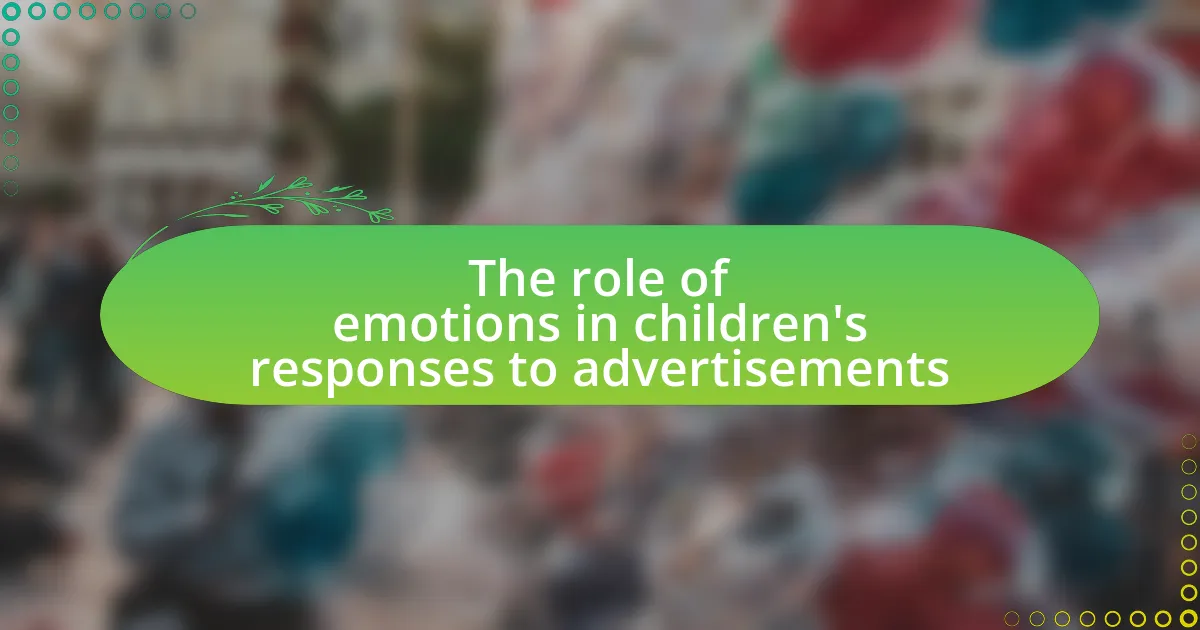The article examines the effects of advertising on children’s social interactions, highlighting how exposure to advertisements shapes their preferences, behaviors, and peer relationships. It discusses the development of materialistic values among children, leading to social comparisons and peer pressure to acquire advertised products. The article also explores the influence of different types of advertisements, the role of parents in mediating these effects, and the long-term consequences on children’s social skills and self-esteem. Additionally, it emphasizes the importance of responsible advertising practices aimed at children to foster healthy social interactions and development.
What are the effects of advertising on children’s social interactions?
Advertising significantly influences children’s social interactions by shaping their preferences, behaviors, and peer relationships. Children exposed to advertising often develop materialistic values, which can lead to social comparisons and peer pressure to acquire advertised products. Research indicates that children who frequently view commercials are more likely to engage in competitive behaviors with peers, as they may feel the need to possess the latest toys or gadgets to fit in. A study published in the Journal of Consumer Research found that children aged 8 to 12 who were exposed to high levels of advertising reported feeling more pressure to conform to their peers’ expectations regarding possessions. This dynamic can create a cycle where social interactions are increasingly centered around consumerism, potentially undermining genuine relationships and emotional connections among children.
How does advertising influence children’s behavior in social settings?
Advertising significantly influences children’s behavior in social settings by shaping their preferences, peer interactions, and consumption habits. Children exposed to advertisements often develop brand loyalty and preferences for specific products, which can lead to social pressure among peers to conform to these preferences. For instance, a study published in the journal “Pediatrics” found that children who viewed food advertisements were more likely to choose those advertised products during social gatherings, demonstrating a direct link between advertising exposure and food choices in social contexts. Additionally, advertisements often portray idealized lifestyles and social norms, which can affect children’s self-esteem and social dynamics, as they may feel compelled to emulate the behaviors and possessions depicted in ads.
What types of advertisements are most impactful on children?
Television advertisements featuring animated characters and popular children’s media are the most impactful on children. Research indicates that children are more likely to engage with ads that utilize colorful visuals, catchy jingles, and characters they recognize from their favorite shows. A study published in the Journal of Advertising Research found that children aged 6 to 12 are significantly influenced by advertisements that incorporate these elements, leading to increased brand recall and preference. Additionally, advertisements that promote toys or food items often leverage peer influence and social validation, further enhancing their impact on children’s purchasing behavior.
How do children’s perceptions of social norms change due to advertising?
Children’s perceptions of social norms change due to advertising by shaping their understanding of acceptable behaviors and values. Advertising often portrays idealized lifestyles, behaviors, and products that children come to associate with social acceptance and popularity. For instance, studies have shown that children exposed to advertisements featuring peer approval or social success linked to specific products are more likely to adopt those behaviors and preferences, thereby altering their perceptions of what is considered normal or desirable in their social circles. Research by the American Psychological Association indicates that children as young as 8 can internalize these messages, leading to shifts in their social interactions and expectations based on the norms presented in advertisements.
Why is it important to study the effects of advertising on children?
Studying the effects of advertising on children is crucial because it influences their social interactions and development. Children are particularly susceptible to advertising messages, which can shape their preferences, behaviors, and social norms. Research indicates that exposure to advertising can lead to materialistic values and unhealthy lifestyle choices, impacting their relationships with peers and family. For instance, a study published in the journal “Pediatrics” found that children exposed to food advertising are more likely to choose unhealthy snacks, which can affect their social interactions during meals and play. Understanding these effects helps in creating regulations and educational programs that protect children from harmful advertising practices.
What are the potential long-term consequences of advertising on children’s social skills?
Advertising can negatively impact children’s social skills in the long term by promoting materialism and reducing face-to-face interactions. Research indicates that children exposed to high levels of advertising may prioritize consumerism over interpersonal relationships, leading to difficulties in developing empathy and effective communication skills. A study published in the Journal of Consumer Research found that children who frequently engage with advertisements are more likely to exhibit selfish behaviors and less likely to share or cooperate with peers. This shift in focus from social engagement to material acquisition can hinder their ability to form meaningful relationships and navigate social situations effectively.
How does advertising shape children’s understanding of relationships?
Advertising shapes children’s understanding of relationships by presenting idealized and often unrealistic portrayals of social interactions. These portrayals frequently emphasize materialism, attractiveness, and social status as key components of relationships, which can lead children to develop skewed perceptions of what constitutes healthy connections. Research indicates that children exposed to advertisements are more likely to associate love and friendship with consumer products, as evidenced by a study published in the Journal of Advertising Research, which found that children aged 6 to 12 often equate social acceptance with brand affiliation. This influence can result in children prioritizing superficial qualities over emotional bonds, ultimately affecting their social development and interpersonal skills.
What role do parents play in mediating advertising effects on children?
Parents play a crucial role in mediating the effects of advertising on children by guiding their understanding and interpretation of marketing messages. They can influence children’s perceptions of advertisements through discussions about the content, teaching critical thinking skills, and setting limits on media consumption. Research indicates that parental involvement, such as co-viewing advertisements and engaging in conversations about them, can significantly reduce the likelihood of children developing materialistic attitudes and unhealthy consumption habits. For instance, a study published in the Journal of Consumer Research found that children whose parents actively discussed advertisements were less likely to be swayed by persuasive marketing tactics. This demonstrates that parents can effectively buffer the impact of advertising by fostering a critical perspective in their children.
How can parents help children critically evaluate advertisements?
Parents can help children critically evaluate advertisements by engaging them in discussions about the content and intent of ads. By asking questions such as “What do you think this ad is trying to sell?” or “How does this ad make you feel?”, parents encourage children to analyze the persuasive techniques used. Research indicates that children who participate in discussions about media are better equipped to understand advertising strategies, as highlighted in a study by the American Psychological Association, which found that critical thinking skills improve with parental involvement in media literacy. This active engagement fosters a more discerning view of advertisements, enabling children to recognize exaggerations and emotional appeals.
What strategies can parents use to discuss advertising with their children?
Parents can use several strategies to discuss advertising with their children, including encouraging critical thinking, using real-life examples, and fostering open dialogue. Encouraging critical thinking involves asking children questions about advertisements, such as what message the ad is trying to convey and whether it is realistic. Using real-life examples, such as discussing specific ads seen on television or online, helps children relate to the topic and understand the persuasive techniques used. Fostering open dialogue allows children to express their thoughts and feelings about advertising, promoting a deeper understanding of its impact on their social interactions and consumer behavior. Research indicates that children who engage in discussions about advertising are better equipped to recognize persuasive tactics and make informed choices, ultimately leading to healthier social interactions.
How do different types of media affect children’s social interactions?
Different types of media significantly influence children’s social interactions by shaping their communication skills, social behaviors, and peer relationships. For instance, television and online platforms often expose children to various social norms and behaviors, which can either enhance or hinder their ability to interact with peers. Research indicates that children who engage with interactive media, such as video games that promote teamwork, tend to develop better social skills compared to those who consume passive media like traditional television. A study published in the journal “Child Development” by Gentile et al. (2009) found that children who play cooperative video games exhibit improved social interactions and teamwork abilities. Conversely, excessive exposure to media that promotes negative stereotypes or aggressive behavior can lead to social withdrawal or increased aggression in real-life interactions. Thus, the type of media consumed plays a crucial role in determining the quality and nature of children’s social interactions.
What are the implications of advertising on children’s peer relationships?
Advertising significantly influences children’s peer relationships by shaping their preferences, behaviors, and social dynamics. Children exposed to targeted advertisements often develop desires for specific products, which can lead to social exclusion or inclusion based on their ability to acquire those items. For instance, a study published in the journal “Pediatrics” found that children who are frequently exposed to advertisements for popular toys are more likely to experience peer pressure to own those toys, impacting their social standing among peers. Additionally, advertising can create unrealistic standards of popularity and success, leading to feelings of inadequacy among children who cannot meet those standards, thereby affecting their self-esteem and social interactions.
How does advertising contribute to social comparison among children?
Advertising contributes to social comparison among children by presenting idealized images and lifestyles that children aspire to emulate. This exposure to curated representations of success, beauty, and happiness creates benchmarks against which children measure their own lives and self-worth. Research indicates that children who frequently view advertisements are more likely to engage in social comparison, leading to feelings of inadequacy and lower self-esteem. For instance, a study published in the Journal of Consumer Research found that children exposed to advertisements featuring attractive peers reported higher levels of social comparison and dissatisfaction with their own appearance. This dynamic illustrates how advertising not only influences children’s desires but also shapes their perceptions of social norms and personal value.
What impact does advertising have on children’s self-esteem in social contexts?
Advertising negatively impacts children’s self-esteem in social contexts by promoting unrealistic standards of beauty and success. Research indicates that exposure to idealized images in advertisements can lead to body dissatisfaction and lower self-worth among children. A study published in the journal “Pediatrics” found that children who viewed advertisements featuring thin models reported higher levels of body dissatisfaction and lower self-esteem compared to those who viewed neutral content. This diminished self-esteem can affect children’s social interactions, leading to feelings of inadequacy and exclusion in peer groups.
What are some best practices for responsible advertising aimed at children?
Responsible advertising aimed at children should prioritize transparency, age-appropriate content, and educational value. Advertisers must ensure that messages are clear and not misleading, as children may struggle to differentiate between entertainment and advertising. Content should be designed to be suitable for the target age group, avoiding themes that could promote unhealthy behaviors or unrealistic expectations. Additionally, incorporating educational elements can enhance the value of advertisements, fostering positive social interactions and learning opportunities. Research indicates that advertisements with educational content can lead to improved cognitive development and social skills among children, reinforcing the importance of responsible advertising practices.






